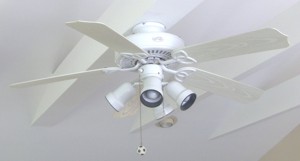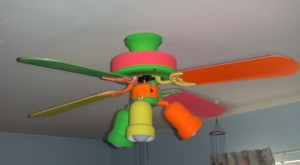Ceiling Fans
Ceiling fans are a great way to provide both comfort and style to any room of you home, even ones outdoors. I have multiple ceiling fans in my own home, and am thinking of adding more. But I just don't buy any brand, as over the years I have learned that ceiling fans are like many other things. If you want a ceiling fan that will operate quietly and reliably, then you must pay more money when you buy the fan.
Ceiling fans come in different sizes, and this is important to keep in mind depending upon the size of the room you are trying to cool. If the room you are trying to cool is larger, always get a ceiling fan that has a blade span greater than 50 inches.
The way a ceiling fan works is very simple. As we perspire, the heat from our bodies is transferred to the liquid perspiration on the surface of our skin. When a breeze blows across our skin, it evaporates the liquid perspiration. As the liquid sweat turns into water vapor, it takes the heat from your body into the air. This is the exact same mechanism that fuels monster hurricanes. Heat from the ocean water is carried up into the gathering storm as the warm ocean water evaporates. .

This ceiling fan is in a large sun room. PHOTO CREDIT: Roger Henthorn
To achieve maximum cooling, a ceiling fan has to move lots of air. The distance the fan is from the ceiling and the tilt or pitch of the fan blades must be optimized. If a ceiling fan is too close to a ceiling, say six inches or less, it can't easily get the needed air to push down towards the floor. Just the same, the fan blades must have a tilt to them so they cut through the air and push it down. Airplane and ship propellers operate the same way. They slice through air or water to push objects that weigh many tons.
Ceiling fans that have a blade pitch of 15 degrees work very well. Those fan manufacturers that take the time to perfectly balance the fan blades and mounting hardware do even better. As the fan blades spin around, they need to be balanced just like a car wheel or a washing machine. If you have ever heard an out-of-balance washing machine rattle when it is in its spin cycle, then you know why it is important to have balanced ceiling-fan blades.
Ceiling fans can save you lots of money on air conditioning costs. If you use a ceiling fan in the early parts of the day before the sun bakes your home, you can get effective cooling in the room you are occupying. There is no reason to air condition the entire home if you are just in one place within your home. A ceiling fan uses only a fraction of the electricity that is required to operate a central air-conditioning system.

A smaller ceiling fan for a kid's bedroom. PHOTO CREDIT: Roger Henthorn
If your home is well-sealed, the air inside will still have a lower relative humidity from the operation of the air conditioner the day before. This lower level of humidity will help evaporate the sweat from your skin, even if you don't feel yourself perspiring.
I think it is a great idea to install ceiling fans in all bedrooms, kitchens, family rooms, or any room where you might sit to relax or work. I would also place a ceiling fan on a covered screened porch or even a patio that has some type of awning or other cover to keep rain water from falling onto the fan.
Keep in mind that even when a fan is operating at a very slow speed, it can provide enough cooling to keep you very comfortable. The fan does not need to be blasting you with air as if you were in a gale.
Be sure to purchase a ceiling fan that can be operated with a speed control. Many models have built-in micro processors that allow you to set the fan speed from a wall control. What's more, the fan motor can spin in reverse to pull air up from the ground in winter months. This reverse action takes warmer air from a ceiling and distributes it to lower levels in the room.
Column EM0045